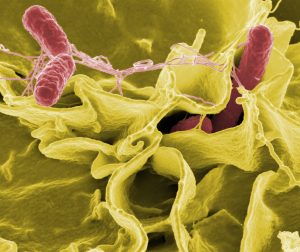5.3 Biological Hazards

As we saw in Chapter 3, biological hazards are organisms or the products of organisms (e.g., tissue, blood, feces) that harm human health. There are three types of organisms that give rise to biological hazards:
- Bacteria are microscopic organisms that live in soil, water, organic matter, or the bodies of plants and animals. For example, the E. coli bacterium lives in human and animal digestive tracts and some strains can cause food poisoning, infections, or kidney failure when ingested.
- Viruses are a group of pathogens that cause diseases such as influenza (the “flu”) when they enter our bodies.
- Fungi are plants that lack chlorophyll, including mushrooms, yeast, and mould. Many fungi contain toxin or produce toxic substances. For example, stachybotrys chartarum (black mould) produces toxins called mycotoxins that cause nausea, fatigue, respiratory and skin problems, and organ damage when the toxic spores are inhaled.
Insect stings and bites, poisonous plants and animals, and allergens are also biological hazards. Like chemical hazards, biological hazards can enter our bodies via respiration, skin absorption, ingestion, and skin penetration and can cause both acute and chronic health effects. Our bodies do have mechanisms by which to cope with some biological hazards. For example, our respiratory system has five layers of defence to prevent harmful particles from entering our body, beginning with the hair-like projections (cilia) on the cells that line our airways (which filter out particles) and ending with cells (macrophages) in the air sacs (alveoli) of our lungs that trap and route impurities into the lymphatic system for disposal. Organisms that enter our body are also subject to attack by our immune system. Yet these mechanisms are not effective against every biological hazard or every exposure.
Like all workplace hazards, control strategies for biological hazards should follow the hierarchy of controls. Historically, the provision of adequate washing and toilet facilities was an engineering control that significantly reduced worker exposure to many biological hazards. Recent technological improvements, such as automatically flushing toilets and automatic taps, soap dispensers, and towel dispensers, have further limited workers’ contact with bacteria in washrooms.
As noted in Box 5.3, providing workers with vaccinations is an administrative control that can reduce worker susceptibility to viruses. Mandatory vaccinations are, however, controversial. Public health officials in Alberta have been attempting to increase the rate of annual vaccination for influenza among health-care workers (which sits at about 55%) and are considering mandatory vaccinations. In British Columbia, workers who do not receive a flu shot must wear a mask when interacting with patients.[1]
While mandatory vaccination for health-care staff is advocated as an important step to protect patients (who may be particularly vulnerable to influenza), opponents note that mandatory vaccination significantly interferes with the rights of health-care workers to control their own health and that the annual “flu shot” is only about 60% effective at preventing influenza.[2] Some critics privately assert that employers may be more interested in reducing worker sick-time totals than protecting patient health. This charge should again draw our attention to the potential for financial considerations to affect employer OHS practices.
Communicable diseases, immunization, and child care workers
Public immunization programs during the latter half of the 20th century—focused specifically on vaccinating school children—have largely eliminated diseases such as polio and smallpox. While primarily aimed at controlling disease in the broader population, vaccination programs have also reduced occupational exposures to biological hazards among health-care and child-care workers.
A since-discredited 1998 study that linked autism to the MMR (mumps, measles, and rubella) vaccine has contributed to declining vaccination rates in Canada and the United States. Fewer immunized children means that child-care workers—95% of whom are female—are increasingly exposed to biological hazards that can cause diseases, such as hepatitis B and measles.
Indeed, child-care workers face many biological hazards in the course of their daily work. Respiratory infections—spread through the air—are commonplace among children, as are measles, chicken pox, and whooping cough. Intestinal infections can be spread through contact with feces during diapering or through inadequate hand washing. And skin infections (such as ring worm) and infestations (such as lice) can be transmitted through direct contact.
Following a 2014 outbreak of measles in Disneyland linked to unvaccinated children, the State of California made vaccination of school-aged children mandatory. The state has since enacted further legislation requiring child-care workers to be vaccinated against measles, whooping cough, and influenza [3] Mandatory worker vaccination (which is controversial) helps to control some of the biological hazards faced by child-care workers. Other administrative controls include environmental monitoring and sanitization protocols, such as ensuring that there are adequate facilities for diapering and toileting and physically separating these areas from food preparation and eating areas.
The interaction of public health campaigns (such as immunization) with workplace OHS demonstrates the need for OHS practitioners to be mindful of health issues beyond the workplace. In Chapter 8, we’ll examine the issue of pandemic planning. Pandemics are caused by the widespread outbreak of a new strain of a virus that spreads quickly (due to a lack of immunity) and for which there is no immediately available vaccination. While they are relatively rare, the workplace impact of a pandemic could be severe and many employers have developed plans for coping with such an event.
- CTV. (2014, December 1). Doctors split on mandatory flu vaccines for health-care workers. http://www.californiahealthline.org/capitol-desk/2015/8/committee-oks-vaccine-requirement-for-day-care-workers-floor-vote-next ↵
- Simons, P. (2014, January 4). Time for Alberta’s health care workers to roll up their sleeves and get the flu shot. Edmonton Journal. http://www.edmontonjournal.com/health/ns+Time+Alberta+health+care+workers+roll+their+sleeves+shot/9348177/story.html ↵
- Simmons, C. (2015, October 11). Gov.Brown signs California day care centre worker vaccination bill–SB 792. California Newswire. http://californianewswire.com/gov-brown-signs-california-day-care-center-worker-vaccination-bill-sb792/ ↵
Workplace hazards potentially giving rise to injuries caused by organisms—such as bacteria, molds, funguses—or the products of organisms that harm human health.
Microscopic organisms that live in soil, water, organic matter, or the bodies of plants and animals.
A group of pathogens that cause disease.
An administrative control that can reduce worker susceptibility to viruses through inoculation.

